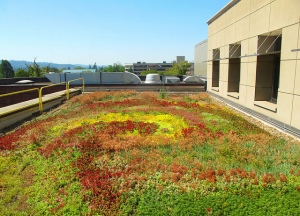 Family: Crassulaceae
Family: Crassulaceae
Genus: Sedum
Species: Sedum acre
Common names: goldmoss stonecrop, mossy stonecrop, goldmoss sedum, biting stonecrop, wallpepper Swedish name: gul fetknopp
Sedum is a large genus of flowering plants commonly known as stonecrop. The genus has up to 600 species of leaf succulents, varying from annual and creeping herbs to shrubs. The plants have water-storing leaves. Sedum species are found throughout the Northern Hemisphere.
Many sedums are cultivated as garden plants, due to their interesting and attractive appearance and hardiness. The various species differ in their requirements; some are cold-hardy but do not tolerate heat, some require heat but do not tolerate cold. Numerous hybrid cultivars have been developed. Sedum can be used to provide a roof covering in green roofs.
The leaves of most stonecrop are edible. But the ones of Sedum acre are somewhat toxic. The leaves contain an acrid fluid that also can cause skin rashes. It is native to Europe, but also naturalised in North America and New Zealand. In the wild Sedum acre grows in thin dry soils and can be found on shingle, beaches, dry-stone walls, dry banks, seashore rocks, roadside verges, wasteland and in sandy meadows near the sea. It can survive half a year without soil and water.

Sedum acre. Photo: Dick Culbert ©
Description: Sedum acre is a tufted perennial herb that forms mat-like stands. The stems are short and densely covered in leaves. At the flowering time in early summer (June-July), the stems lengthen and often gets pinkish-brown with the leaves further apart. The leaves are fleshy and shortly cylindrical with a rounded tip, like a sausage. Sometimes they have a touch of red. The starry flowers have bright yellow petals.
How to grow: Sedum acre is used in hanging baskets and container gardens, as a trailing accent, in borders, or as groundcover. It spreads when allowed to do so, but is easily controlled, being shallow-rooted. It grows as a creeping ground cover, often in dry sandy soil, but also in the cracks of masonry. It grows well in poor soils, sand, rock gardens, and rich garden soil, under a variety of light levels. With one exception it does not thrive in dense shade with limited water.
Living Roof – Sedum roof covering
Living roofs are not a new thing. It has a long history and due to its many advantages it has made a come back in todays societies. Green roofing reduces the heat radiation, cleans the air from carbon dioxide and pollutants. It also reduces the load on the stormwater system and conserves energy. Green roofs also provide habitats for plants, insects, and animals that otherwise have limited natural space in cities. All this makes green roofing a sustainable alternative to traditional roofs. And I think it is beautiful to see a living roof instead of a dead flat space. What do you think about green roofing?

Photo: Wolfram Burner ©
© The photos are licensed by Creative Commons and some rights are reserved. License Attribution 2.0


Love the living roof!
Yvonne
LikeLiked by 1 person
I like sedums, and that living roof was neat!
https://pronetoponder.wordpress.com/
https://serenadedinseconds.wordpress.com/
A-Z Challenge- “Blossoming Verses”
LikeLiked by 1 person
I would love to have a green roof but my roof is too steep to consider it and I’m not sure the building was built with enough strength to hold the extra weight.in the areas where the roof has less pitch. The insulation value would be the main reason I would like to have a green roof.
LikeLiked by 1 person
You are thinking the right way. Maybe you got a shed or something that would look great with a stonecrop roof 🙂
LikeLike
I have this sedum growing in my bank It hasn’t started blooming yet but it should soon. It is so pretty when it does bloom. Thanks for sharing your information.
LikeLiked by 1 person
Thank you Marla! I would love to see your sedum in bloom.
LikeLike
This is one of those plants that look better from a far.
LikeLike
Looking at the roof I agree. But I like the close ups too – showing all the details.
LikeLike